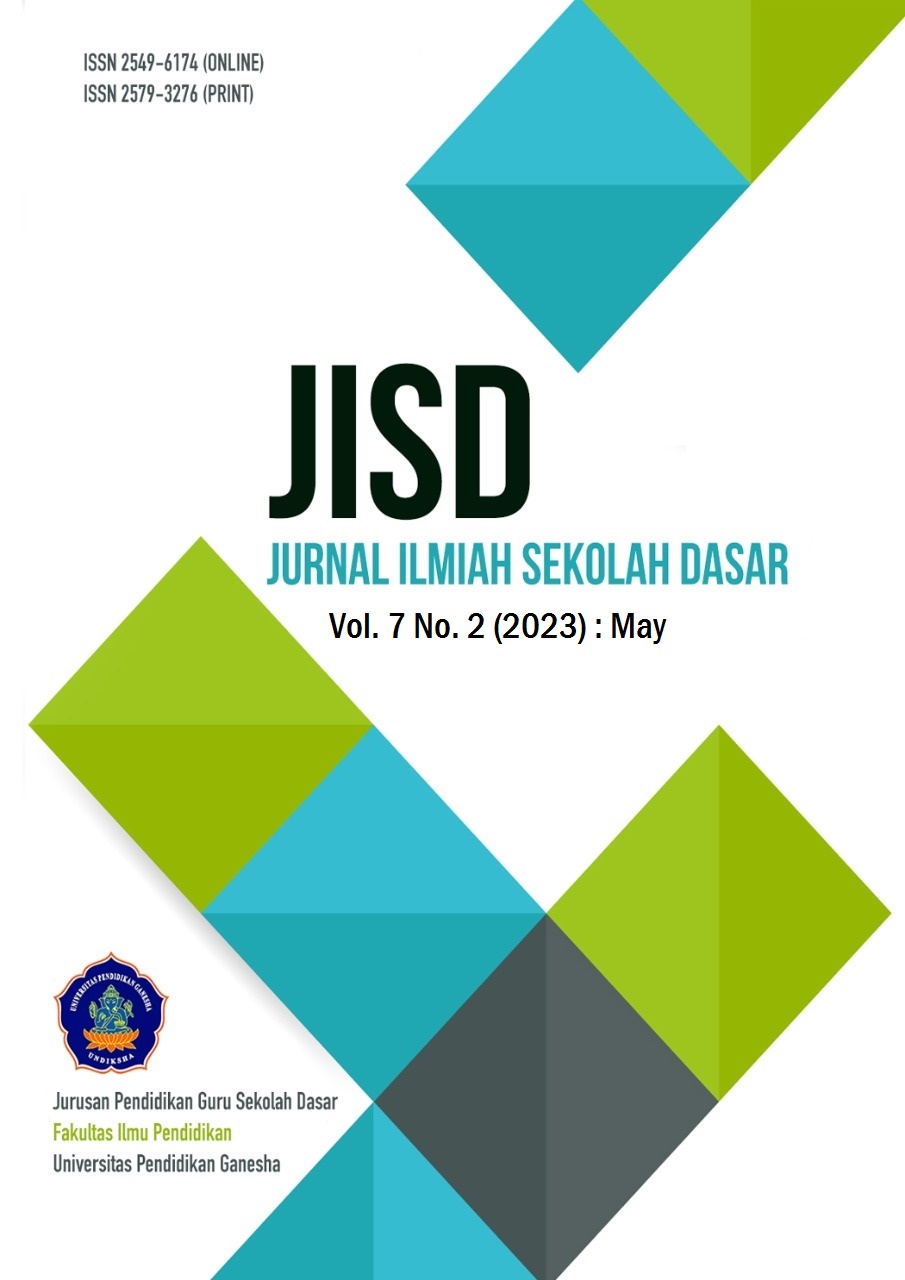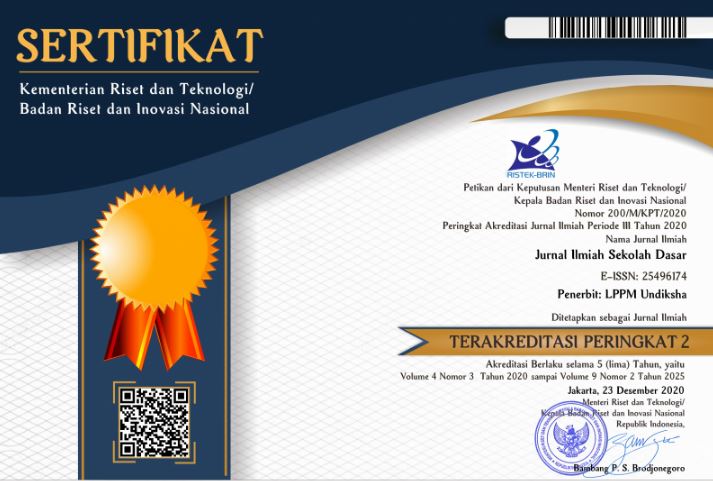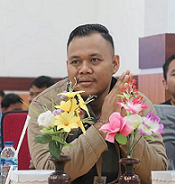Learning Design Innovation Based on Tri N and STEAM in Developing 21st Century Skills for Elementary School Students
DOI:
https://doi.org/10.23887/jisd.v7i2.52903Keywords:
Learning Design Innovation, 21st century skills, Tri N, STEAMAbstract
The low level of 21st-century skills possessed by elementary school students. These 21st-century skills need to be acquired early so that students can be independent, survive, and adapt to the times. This study aims to innovate learning designs based on Tri N and STEAM to develop 21st century skills of elementary school students. The tools developed include lesson plans, student worksheets, and 21st century skills assessment instruments. The learning tool development process consists of analysis, design, development, implementation, and evaluation stages. The research subjects were teachers and grade six students. Data collection techniques using questionnaires, interview sheets, observation sheets and documentation. Data analysis techniques were carried out through descriptive analysis and quantitative analysis. The results showed that Tri N and STEAM-based learning tools developed had integrated characteristics with niteni, niroake, nambahake steps, and activities designed to integrate aspects of science, technology, engineering, art and mathematics. The results of validation of learning tools obtained an average of 3,87 with a very good category. The results of the effectiveness of the developed tools show that the developed tools are effective in developing 21st century skills of students. In a limited trial, there was an increase in the initial average from 2,333 to 3,659 with very good criteria. In the wide trial, there was an increase from the initial average of 2,842 to 3,747 with very good criteria so it can be concluded that the Tri N and STEAM based learning device innovation is effective in developing 21st century skills of elementary school students. based on the data above, it is concluded that Tri N and STEAM-based learning design innovations can develop 21st century skills of elementary school students.
References
Aguilera, D., & Ortiz-Revilla, J. (2021). Stem vs. Steam education and student creativity: A systematic literature review. Education Sciences, 11(7). https://doi.org/10.3390/educsci11070331. DOI: https://doi.org/10.3390/educsci11070331
Arwanda, P., Irianto, S., & Andriani, A. (2020). Pengembangan Media Pembelajaran Articulate Storyline Kurikulum 2013 Berbasis Kompetensi Peserta Didik Abad 21 Tema 7 Kelas Iv Sekolah Dasar. Al-Madrasah: Jurnal Pendidikan Madrasah Ibtidaiyah, 4(2), 193. https://doi.org/10.35931/am.v4i2.331. DOI: https://doi.org/10.35931/am.v4i2.331
Castaner, X., & Oliveira, N. (2020). Collaboration, Coordination, and Cooperation Among Organizations: Establishing the Distinctive Meanings of These Terms Through a Systematic Literature Review. Journal of Management, 46(6), 965–1001. https://doi.org/10.1177/0149206320901565. DOI: https://doi.org/10.1177/0149206320901565
Darhim, Prabawanto, S., & Susilo, B. E. (2020). The effect of problem-based learning and mathematical problem posing in improving student’s critical thinking skills. International Journal of Instruction, 13(4), 103–116. https://doi.org/10.29333/iji.2020.1347a. DOI: https://doi.org/10.29333/iji.2020.1347a
Degeng, S., I. N., S., Rinanityas, E. P., Prihatin, Priawasana, Mais, A., & Usman, U. (2021). The Effect of PBL-based STEAM Approach on The Cognitive and Affective Learning Outcomesof Primary School. Turkish Journal of Computer and Mathematics Education (TURCOMAT), 12(6). https://doi.org/10.17762/turcomat.v12i6.5521. DOI: https://doi.org/10.17762/turcomat.v12i6.5521
Dewantara, K. H. (2013). Pemikiran, konsepsi, keteladanan, sikap merdeka (II) Kebudayaan. Majelis Luhur Tamansiswa.
Ekeowa Kelvin-Iloafu, L. (2016). The Role of Effective Communication in Strategic Management of Organizations. International Journal of Humanities and Social Science, 6(12).
Forster, J. (2015). The Significance of Creativity in Our Lives. International Journal for Talent Development and Creativity, 3(1), 53–68.
Henriksen, D. (2014). Full STEAM Ahead: Creativity in Excellent STEM Teaching Practices. STEAM, 1(2), 1–9. https://doi.org/10.5642/steam.20140102.15. DOI: https://doi.org/10.5642/steam.20140102.15
Hidayat, F, & Nizar, M. (2021). Model Addie (Analysis, Design, Development, Implementation and Evaluation) dalam Pembelajaran Pendidikan Agama Islam. JIPAI: Jurnal Inovasi Pendidikan Agama Islam, 1(1), 28–38. https://doi.org/10.22236/JPI.V11I1.5033.
Hidayat, Fitria, & Nizar, M. (2021). Model Addie (Analysis, Design, Development, Implementation And Evaluation) Dalam Pembelajaran Pendidikan Agama Islam. JIPAI: Jurnal Inovasi Pendidikan Agama Islam, 1(1), 28–38. https://doi.org/10.22236/JPI.V11I1.5033. DOI: https://doi.org/10.15575/jipai.v1i1.11042
Karakoç, M. (2016). The Significance of Critical Thinking Ability in terms of Education. International Journal of Humanities and Social Science, 6(7).
Kartika, E. F. R., Susanti Vh, E., & Indriyanti, N. Y. (2021). Development and validation of web-based STEAM online platform to improve learning quality in pre-service Chemistry teacher. Journal of Technology and Science Education, 11(2), 513–525. https://doi.org/10.3926/JOTSE.1316. DOI: https://doi.org/10.3926/jotse.1316
Kintu, M. J., Zhu, C., & Kagambe, E. (2017). Blended learning effectiveness : the relationship between student characteristics , design features and outcomes. International Journal of Educational, 14(7), 1–20. https://doi.org/10.1186/s41239-017-0043-4. DOI: https://doi.org/10.1186/s41239-017-0043-4
L E W Fajari, Sarwanto, C. (2020). Influence of PBL-based multimedia and learning motivation on students ’ critical-thinking skills in elementary schools Influence of PBL-based multimedia and learning motivation on students ’ critical -thinking skills in elementary schools. Journal of Physics: Conference Series, 1–9. https://doi.org/10.1088/1742-6596/1511/1/012012. DOI: https://doi.org/10.1088/1742-6596/1511/1/012012
Lucia, O., Enciso, U., Sofia, D., Del Pilar, M., & Daza, V. (2017). Pensamiento crítico y su importancia en la educación: algunas reflexiones. Rastros Rostros, 19(34). https://doi.org/10.16925/ra.v19i34.2144. DOI: https://doi.org/10.16925/ra.v19i34.2144
Makhrus, M., Harjono, A., Syukur, A. B., & Muntari, S. (2018). Identifikasi kesiapan LKPD guru terhadap keterampilan abad 21 pada pembelajaran IPA SMP. Jurnal Ilmiah Profei Pendidikan, 3(2), 124–128. https://doi.org/10.29303/jipp.v3i2.20. DOI: https://doi.org/10.29303/jipp.v3i2.20
Mariano, W. K., & Chiappe. (2021). century skills and their relationship to STEAM learning environments: a review. Revista de Educación a Distancia (RED, 21(68). https://doi.org/10.6018/red.470461. DOI: https://doi.org/10.6018/red.470461
Nisa, A. F., Prasetyo, Z. K., & Istiningsih. (2020). The Teachings of Ki Hadjar Dewantara in Improving the Character of Elementary School Students in the Revolution of Industry 4.0 Era. 49–56. https://doi.org/10.2991/ASSEHR.K.200204.010. DOI: https://doi.org/10.2991/assehr.k.200204.010
Nisa, A. F., Prasetyo, Z. K., Istiningsih, Niteni, N., & Nambahake. (2019). Dalam Mengembangkan Kreativitas Siswa Sekolah Dasar. El Midad, 11(2), 101–106. https://doi.org/10.20414/elmidad.v11i2.1897. DOI: https://doi.org/10.20414/elmidad.v11i2.1897
Nurhasanah, A., & Zelela. (2021). Penerapan Pembelajaran Inovatif STEAM di Sekolah Dasar. JIKAP PGSD: Jurnal Ilmiah Ilmu Kependidikan, 5(2), 204. https://doi.org/10.26858/jkp.v5i2.20309. DOI: https://doi.org/10.26858/jkp.v5i2.20309
Pasani, C. F., & Amelia, R. (2021). Introduction of the integrative STEAM approach as a learning innovation in the COVID-19 pandemic in South Kalimantan. Journal of Physics: Conference Series, 1. https://doi.org/10.1088/1742-6596/1832/1/012029. DOI: https://doi.org/10.1088/1742-6596/1832/1/012029
Perignat, E., & Katz-Buonincontro, J. (2019). STEAM in practice and research: An integrative literature review. Thinking Skills and Creativity, 31, 31–43. https://doi.org/10.1016/j.tsc.2018.10.002. DOI: https://doi.org/10.1016/j.tsc.2018.10.002
Peters-burton, E. E., & Stehle, S. M. (2019). Developing student 21 st Century skills in selected exemplary inclusive STEM high schools. International Journal of STEM Education, 1, 1–15.
Priyono, Soesatyo, Y., & Tri Wijayati, D. (2018). Influence of Cooperative Learning Model, Conventional and Motivation Study Of Student Results. 43(2).
Rahardjo, M. M. (2019). How to use Loose-Parts in STEAM? Early Childhood Educators Focus Group discussion in Indonesia. JPUD - Jurnal Pendidikan Usia Dini, 13(2), 310–326. https://doi.org/10.21009/jpud.132.08. DOI: https://doi.org/10.21009/JPUD.132.08
Roebianto, A. (2020). The Effects of Student’s Attitudes and Self-Efficacy on Science Achievement. Jurnal Pengukuran Psikologi dan Pendidikan Indonesia (JP3I), 9(1), 1–10. https://doi.org/10.15408/jp3i.v9i1.14490. DOI: https://doi.org/10.15408/jp3i.v9i1.14490
Rustandi, A., & Rismayanti. (2021). Penerapan Model ADDIE dalam Pengembangan Media Pembelajaran di SMPN 22 Kota Samarinda. Jurnal Fasilkom, 11(2). https://doi.org/10.37859/jf.v11i2.2546. DOI: https://doi.org/10.37859/jf.v11i2.2546
Sartono, N., Suryanda, A., Leyli, T. S. A., & Zubaidah. (2020). Implemetasi STEAM dalam Pembelajaran Biologi : Upaya Pemberdayaan Guru Biologi Madrasah Aliyah DKI Jakarta. Baktimas: Jurnal Pengabdian pada Masyarakat, 2(1), 7–14. https://doi.org/10.32672/btm.v2i1.2099. DOI: https://doi.org/10.32672/btm.v2i1.2099
Sarwanto., F., W., L. E., & Chumdari. (2021). Open-Ended Questions to Assess Critical-Thinking Skills in Indonesian Elementary School. International Journal of Instruction, 14(1), 615–630. https://doi.org/10.29333/iji.2021.14137a. DOI: https://doi.org/10.29333/iji.2021.14137a
Sibaweihi, N., Patel, R. G., Guevara, J. L., Gates, I. D., & Trivedi, J. J. (2021). Real-time steam allocation workflow using machine learning for digital heavy oil reservoirs. Journal of Petroleum Science and Engineering, 199. https://doi.org/10.1016/j.petrol.2020.108168. DOI: https://doi.org/10.1016/j.petrol.2020.108168
Sigit, D. V, Ristanto, R. H., & Mufida, S. N. (2022). Integration of project-based e-learning with STEAM: An innovative solution to learn ecological concept. International Journal of Instruction, 15(3), 23–40. https://doi.org/10.29333/iji.2022.1532a. DOI: https://doi.org/10.29333/iji.2022.1532a
Sugiyono. (2016). Metode Penelitian Kuantitatif, Kualitatif dan R & D. IKAPI.
Supriyoko, S., Nisa, A. F., & Uktolseja, N. F. (2022). The Nature-Based School Curriculum: A Solution To Learning-Teaching That Promotes Students’ Freedom. Jurnal Cakrawala Pendidikan, 41(3), 643–652. https://doi.org/10.21831/cp.v41i3.47903. DOI: https://doi.org/10.21831/cp.v41i3.47903
von der Heiden, B., Fleischer, S., Richert, A., & Jeschke, S. (2011). Theory of Digital Natives in the Light of Current and Future E-Learning Concepts. International Journal of Emerging Technologies in Learning (iJET), 6(2), 37–41. https://doi.org/10.3991/IJET.V6I2.1555. DOI: https://doi.org/10.3991/ijet.v6i2.1555
Wahyuningsih, S., Nurjanah, N. E., Rasmani, U. E. E., Hafidah, R., Pudyaningtyas, A. R., & Syamsuddin, M. M. (2020). STEAM Learning in Early Childhood Education: A Literature Review. International Journal of Pedagogy and Teacher Education, 4(1), 33–44. https://doi.org/10.20961/IJPTE.V4I1.39855. DOI: https://doi.org/10.20961/ijpte.v4i1.39855
Yakman, G., & Lee, H. (2012). Exploring the Exemplary STEAM Education in the U.S. as a Practical Educational Framework for Korea. Journal of The Korean Association For Science Education, 32(6), 1072–1086. https://doi.org/10.14697/JKASE.2012.32.6.1072. DOI: https://doi.org/10.14697/jkase.2012.32.6.1072
Yunawan, I. K. (2014). Niteni, nirokne, nambahi sebagai proses berpikir kreatif. Jurnal Desain Komunikasi Visual, 2(2).
Zayyinah., E., Supardi, Z. A. I., Hariyono, E., & Prahani, B. K. (2022). STEAM-Integrated Project Based Learning Models: Alternative to Improve 21st Century Skills. Advances In Social Science, Education and Humanities Research, 627, 251–258. https://doi.org/10.2991/assehr.k.211229.039. DOI: https://doi.org/10.2991/assehr.k.211229.039
Downloads
Published
How to Cite
Issue
Section
License
Copyright (c) 2023 Ana Fitrotun Nisa, Nurul Hikmah , Pardimin

This work is licensed under a Creative Commons Attribution-ShareAlike 4.0 International License.
Authors who publish with the Journal Ilmiah Sekolah Dasar agree to the following terms:
- Authors retain copyright and grant the journal the right of first publication with the work simultaneously licensed under a Creative Commons Attribution License (CC BY-SA 4.0) that allows others to share the work with an acknowledgment of the work's authorship and initial publication in this journal.
- Authors are able to enter into separate, additional contractual arrangements for the non-exclusive distribution of the journal's published version of the work (e.g., post it to an institutional repository or publish it in a book), with an acknowledgment of its initial publication in this journal.
- Authors are permitted and encouraged to post their work online (e.g., in institutional repositories or on their website) prior to and during the submission process, as it can lead to productive exchanges, as well as earlier and greater citation of published work. (See The Effect of Open Access)










